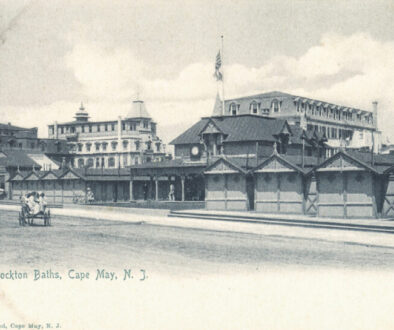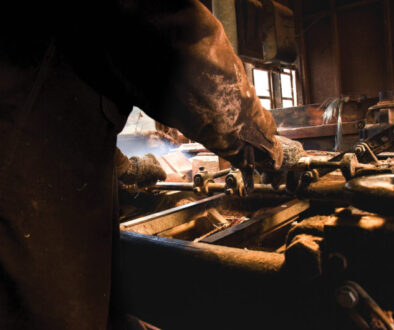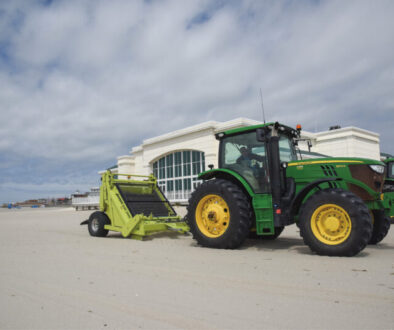In Sync
Enhancing Cape May with integrated design
When you drive into Cape May off the Garden State Parkway and over the bridge, you pass familiar landmarks such as The Lobster House and Mayer’s Tavern, and, if you look carefully, you’ll even see the O’Neill Boathouse [a private residence] nearly hidden on your right. Then, as you make your way farther down Lafayette, you pass a small motel that used to be Cape Winds, which, by the time you read this, will have been reborn as The Boarding House, a completely modern, surf-inspired hideaway.
What you probably don’t know is that one couple is responsible for the look of each of these projects, as well as half a dozen more that might surprise you.



Based in Philadelphia, DAS Architects is one of the country’s top design firms, having developed an exceptional resume of hospitality, retail, corporate, and residential projects. Founded by Susan M. Davidson, IDC and David A. Schultz, AIA in 1990, DAS offers a full range of architectural, interior design, and procurement services.
“We met through mutual friends,” says David. “I had a small startup architectural firm, and Susan was just leaving a big Washington, D.C. firm, and running their Philadelphia office. All her clients wanted to follow her. So, in 1988 a mutual friend put us together and we helped staff Susan to produce her projects. She was doing these incredible corporate interiors—big projects. We started off helping each other business-wise, sharing office space, and she had use of our staff.”
“The truth is, we really connected on all levels,” says Susan. “Communication, how we thought, to the point where we knew what the other was going to say before we said it. It was just a natural connection. So, after a short period of time, we got involved romantically and became a couple—which, by the way was a secret for many, many years. We didn’t tell clients. To this day some clients still don’t know that we’re married.”
In 1990, David and Susan formally merged the two companies and formed DAS, which stands for David and Susan, and it is indicative of their partnership in all aspects of their lives. And how they landed in Cape May is part of the lore of their history together.
“I started coming to Cape May in 1986,” says David. “I came by boat.”
“Makes you sound like Christopher Columbus,” says Susan. We’re sitting in the living room of their home in West Cape May, both of them casually dressed and looking relaxed.
“I came by sailboat,” says David, emphasizing the word for effect. “I bought a sailboat that year and was on the Chesapeake Bay and looking for a place to keep it. Someone suggested that I look into the Cape May Yacht Club. Just two years later, I met Susan, and her very first time coming to Cape May was on my boat. It was a two-day sail from Philadelphia to Cape May and it was a whole new adventure because she’d never sailed before. For the first couple of summers, we lived on the boat.”
“It was more like camping,” says Susan. “But on a boat.”
“We had a bunk and a small galley kitchen,” continues David. “We’d row the dingy to the Yacht Club and use their shower facilities, and that was our weekend. It was fabulous really. For a few summers after that we would rent houses with friends and then in 1988, we bought a piece of property in West Cape May and built this house.”
How David and Susan work together and the way they think about design is an important part of the success of DAS. Unlike other firms which separate architecture and interior design, DAS integrates it holistically.
“Since I’m an architect and Susan an interior designer,” says David, “we always felt very strongly that we should blend both disciplines and deliver projects on a completely integrated basis. It never made any sense to me that other firms didn’t do this—especially for the type of high-design, hospitality projects we do, where you have to connect everything together to deliver the experience. You can’t have an architect and an interior designer on two different pages. It’s super inefficient and usually doesn’t lead to a great result. We integrate everything from the first day.”

“When we first meet with a client, we really focus on the whole vision,” says Susan. “What’s the story you’re telling? What does it look like? What does it feel like? Who is the market? What’s going to make the project unique? For us there is no line between the architecture and the interiors. It’s all part of the vision. In the early stages of a project, we’re looking at the whole thing.”
“There are traditional developers who still believe that the architects should do architecture and the interior designers should do the interiors,” says David, “and that it doesn’t matter if they match, or even if the firms are talking to each other. We think it’s important they match. We’ve been hired to just do the architecture, or just the interiors, and then because of our process, we end up with the whole thing. Which proves our point—it’s better integrated than not.”
DAS designs are regularly featured among the country’s top designers in publications such as Hospitality Design, Nation’s Restaurant News, Contract Design, Chef Magazine, Restaurants USA, Retail Design, Interior Design and Interiors. But it’s the work they’ve done in Cape May that separates them from larger firms.
“We’ve gotten involved with many of the locals here,” adds Susan. “Like with Keith [Laudeman] of The Lobster House. We’ve gotten to know his family, his daughter, developing that relationship, and they introduced us to other people. That led us to Hawk Haven [Winery], we’ve worked with the Hirsch family on Harry’s [Ocean Bar & Grill] and now the Boarding House.”
DAS has been involved with enough different projects in Cape May and the surrounding area that they’ve arguably had an important impact on the evolution of the community. In addition to renovations on The Lobster House and Mayer’s Tavern, and the redevelopment of Harry’s Ocean Bar & Grill and The Boarding House, they’ve done a half dozen residential homes in Cape May. Not far outside of town, they are responsible for The Reeds at Shelter Haven in Stone Harbor, and they’re working with the owners of Hawk Haven on expansion opportunities.



“Cape May has really become so special for us,” says David. “We’re here more than we’re in Philadelphia. We spend a part of the work week in Philadelphia, where we have a home, but then the other four days, we’re here. It started out as weekends, and we just kept expanding the weekends. Sundays became Mondays. Mondays became Tuesdays. We never wanted to go home. Obviously because of technology today, we can work remotely. We can communicate with the office, or with clients around the country. We don’t need to be in the office to do our work.”
“Cape May has a small-town feel,” says Susan, “but with a cosmopolitan edge to it. For me, it’s really become my home. All my close friends are here. All my activities and hobbies are here. Horseback riding. All the athletic stuff. Even just cooking, restaurants, shopping, I do it all here to support the locals. It’s my happy place. It’s where I want to be.”
“It’s true,” says David. “We’re much more involved socially in Cape May than we were in Philadelphia.”
DAS is responsible for designing more than 300 signature restaurants, hotels, resorts and luxury residential projects around the country, including Newport, RI, in Forty 1 North, a world-class waterfront hotel destination. Other DAS national highlights include renovations to Jekyll Island Club, an historic resort originally created by J.P. Morgan, the Beacon in Philadelphia, Wolfgang’s Steakhouse in the Tribeca section of Manhattan, and the Salt Creek Grille, a 400-seat modern rustic pub in Los Angeles. They recently opened the Cambria Hotel on Avenue of The Arts in Philadelphia, and will soon open The Harper, a luxury high-rise residential tower off Rittenhouse Square.

But that doesn’t mean they don’t take the time to work on smaller projects that interest them.
“The process is the same, no matter how big or how small the project,” Susan says. “We’re looking for projects that are anything but cookie-cutter. Anything where we can be creatively challenged.”
“That’s really how we got into hospitality,” says David. “Because that’s where you can be creative and try new things.”
That’s how they came to be working on an 11-room motel called Cape Winds, bought by the Hirsch family in 2015, who own The Montreal and Harry’s Ocean Bar & Grill in Cape May.
“Rustic and relaxed, yet decidedly modern, the Boarding House seamlessly weaves laidback vibes with luxury & comfort,” is what the website reads.
“We wanted to create a coastal casual concept for active vacationers,” co-owner Jonathan Hirsch said. “The Boarding House will be a place where shoes are optional, but relaxation is required. We’re doing a complete flip of the existing building and making it into an inviting, beautiful oasis.”
The Boarding House is like a private, secluded getaway with a modern yet rustic feel. Dog friendly, complimentary wine and beer happy hour, free beach tags, complimentary yoga mats, and even a rooftop deck, all make this boutique hotel unique.
Despite its rich history—built by a descendant of a freed slave and eventual North Carolina congressman—the venue had declined in recent years. “The Cape Winds was a sort of “no-tell-motel” where you came and stayed when you couldn’t find another place to stay. It’s not on the beach, and it wasn’t fancy or even Victorian, but it had a certain character to it, and they were smart enough to say, ‘We can save this, and it could be really cool,’” Susan says. “So, we’re working on this great beach vibe, where it’s really familiar and homey, but eclectic as well, with a 50s-60s beach chic, and yet still contemporary.”
“This is not the low-end boarding house concept from years past,” says David. “They’re expecting to attract a young, hip crowd looking for new experiences. They’ve got great vision for what they want to do. Jonathan has wonderful ideas, and he’s really driving this project. I think it’s going to be a great project for Cape May.” Jonathan is the grandson of Harry and Sophie Hirsch, who established the Montreal Beach Resort in 1966, and represents the third generation to own and operate the hotel.


“The work we’ve done in the area has mostly been with friends,” says David. “It’s not like we market to get this work. But because we’re here, we’ve met people. If we can help them, and it seems like it would be a good fit, we help them. There are plenty of good firms in Cape May. We’re not looking to build an office here—it’s mostly been friends. But with the Laudemans and the Hirsch family, they’re professionals in the hospitality business, which is also our business, and I think they were excited that we were locals and could help them. We have a lot of experience, and I think that’s meaningful to them.”
“It started with Keith [Laudeman],” says David. “Funny enough, we met him at a restaurant show in Chicago. He was impressed with our work from another project and someone told him we had a house in Cape May, and since then Keith’s become a good friend. He comes into our office all the time in Philadelphia. He loves getting into the city and trying out new hotels and restaurants—really like a learning experience for him, which we think is great.”
“Keith had been buying up a lot of the land and buildings around The Lobster House, to keep it from becoming overdeveloped,” says Susan. “He wanted to keep the old vibe of a fishing culture, so he knew he was going to need to develop a master plan, which he did. When he bought Mayer’s, he said, ‘Come look at this.’”
At first it seemed to the couple that Laudeman wasn’t sure what he was going to do with the property. “He told us, ‘I might renovate it. I might run it. I might let someone else run it. I might tear it down, I’m not sure,’” David says. “Then he asked for ideas, and we told him he shouldn’t tear it down—which we don’t think he really wanted to do anyway—and then that grew into ‘let’s renovate the whole building.’”
“We began it as a restoration,” says Susan. “To maintain the history and character of what it was, just brought up to date. We were able to save a few things, like the original sign and the bar with its bullet holes and names carved into it, and we while we maintained the skeleton of the building, everything else was starting from scratch. It was a real project.”
“To Keith’s credit, he wanted to keep the building as authentic as possible,” says David. “He wanted to embody its roots as an old fisherman’s pub. He’s really trying to keep the neighborhood the way it was, with buildings and businesses that reflect the history of the area.”
In the end, one of Keith’s daughters Alex Laudeman (a graduate of the Institute of Culinary Education in Manhattan) expressed interest in running the restaurant, and Mayer’s was reborn.
“It’s nice to see these multi-generational families who are buying up properties in town and working hard to maintain an authentic Cape May presence,” says Susan. “As opposed to just building condos.”
“We see a lot of opportunities for other people to be doing this in Cape May,” says David. “To step it up, raise the bar, make it more experiential, so that people want to come for the width and breadth of experiences, and not just to find a hotel. It’s finding an experience. We really hope there are more people, more developers, who are interested in doing these kinds of projects.”
We agree.



